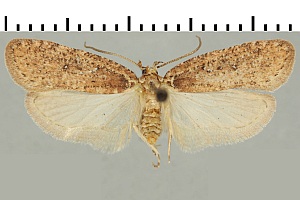Version 6 (neueste) vom 21. April 2023 um 23:48:04 von Erwin Rennwald
Länder:

 +1Kontinente:NA
+1Kontinente:NA


 +1Kontinente:NA
+1Kontinente:NAInhalt
2. Diagnose
2.1. Falter
2.1.1. Männchen
1-2: USA, Washington, Whatcom County, Bagley Creek, 2750 ft, Zucht von Echinopanax horridum, Falterschlupf 7. September 1935, Beleg-Nr. NHMUK010293035 [1] bzw. ohne Nummer [2] (leg. & det. J.F.G. Clarke, coll. NHM London, Foto: Peter Buchner)In Clarke (1941) als Varietät echinopanicis beschrieben. Da Varietäten aber kein gültiger taxonomischer Rang zukommt, wird der Beleg hier nicht als Paratypus ausgewiesen
2.1.2. Weibchen
3. Biologie
3.1. Nahrung der Raupe
- [Apiaceae:] Angelica arguta
- [Apiaceae:] Angelica hendersonii
- [Apiaceae:] Conioselinum chinense
- [Apiaceae:] Ligusticum apiifolium
- [Apiaceae:] Oenanthe sarmentosa
- [Apiaceae:] Osmorhiza chilensis
- [Apiaceae:] Osmorhiza occidentalis
- [Araliaceae:] Echinopanax horridum
Nach Hodges (1974)
4. Weitere Informationen
4.1. Andere Kombinationen
- Depressaria rosaciliella Busck, 1904 (Originalkombination)
4.2. Faunistik
Nord-Amerika: USA, Kanada
4.3. Literatur
- Erstbeschreibung: Busck, A. (1904): Tineid Moths from British Columbia, with Descriptions of New Species. — Proceedings of the United States National Museum 27 (1375): 745-778.
- Clarke, J. F. G. (1941): Revision of the North American moths of the family Oecophoridae, with descriptions of new genera and species. — Proceedings of the United States National Museum 90 (3107): 33-286, pl. 1-48.
- Hodges, R. W. (1974): The Moths of America North of Mexico Including Greenland. Fascicle 6.2. Gelechioidea Oecophoridae: pp. 1-142, pl. 1-7, pp. V-X. London (E. W. Classey limited and R. B. D. Publications Inc.).






